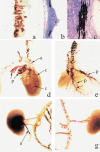Warfarin exposure and calcification of the arterial system in the rat
- PMID: 10718864
- PMCID: PMC2517807
- DOI: 10.1046/j.1365-2613.2000.00140.x
Warfarin exposure and calcification of the arterial system in the rat
Abstract
There is evidence from knock-out mice that the extrahepatic vitamin K-dependent protein, matrix gla protein, is necessary to prevent arterial calcification. The aim of this study was to determine if a warfarin treatment regimen in rats, designed to cause extra-hepatic vitamin K deficiency, would also cause arterial calcification. Sprague-Dawley rats were treated from birth for 5-12 weeks with daily doses of warfarin and concurrent vitamin K1. This treatment causes an extrahepatic vitamin K deficiency without affecting the vitamin K-dependent blood clotting factors. At the end of treatment the rats were killed and the vascular system was examined for evidence of calcification. All treated animals showed extensive arterial calcification. The cerebral arteries and the veins and capillaries did not appear to be affected. It is likely that humans on long-term warfarin treatment have extrahepatic vitamin K deficiency and hence they are potentially at increased risk of developing arterial calcification.
Figures

References
-
- Drury RAB, Wallington EA. Carleton's Histological Technique. London: Oxford University Press; 1976. pp. 150–151.
-
- Ducy P, Desbois C, Boyce B, et al. Increased bone formation in osteocalcin-deficient mice. Nature. 1996;382:448–452. - PubMed
-
- Esnouf MP, Prowse CV. The gamma-carboxy glutamic acid content of human and bovine prothrombin following warfarin treatment. Biochim. Biophys. Acta. 1977;490:471–476. - PubMed
MeSH terms
Substances
LinkOut - more resources
Full Text Sources
Medical

